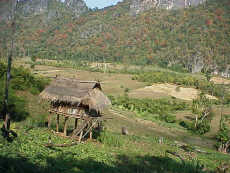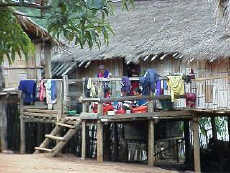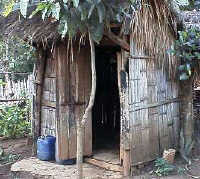Of Curries and Common Ground (1 of 2)
Chiang Mai, Thailad


Elephant-eye-view of the countryside north of Chiang Mai.
![]()
![]()
As the pickup truck wound through the hills of northern Thailand I had one of those moments that hits every traveler at some point, that sense of amazement that one is actually in such a foreign place far from home. We were on our way to a remote hill tribe village somewhere in northern Thailand near the Burmese border. I realized that not only did I not know exactly where we were going, neither did anyone back home. No matter, we were on our way for three days of cooking classes and village visits, and I was just trying to take it all in.
One of the main reasons many people go to Chiang Mai in northern Thailand is to go on a trek up into the mountains to see the hill tribes. Most treks last 3 days and include lots of walking through the jungle, an elephant ride, a river raft ride, sleeping in villages, and gawking at the locals who may or may not want you there. Some people come to smoke the opium that is grown in the hills and used by many of the tribal elders. We weren’t interested, and in fact had avoided the treks with testimonials from satisfied customers who said they found lots of “mind-bending substances” along the way.
The “trek” we chose was slightly different. It included transportation to a tribal village, all food, four cooking classes, an elephant ride, and a raft ride. The difference between this one and the others was that we were in one village for three days, instead of spending most of our time walking through the underbrush. It also included cooking classes, and we were the only people on the trip, so it seemed very personalized. Our guide and cooking teacher, a Thai man named Noi, spoke the local Burmese dialect of the villagers as well as English.


Washing hangs on railings outside one of the typical village houses.
![]()
![]()
The classes were my main reason for going; I had been a professional chef for years and wanted to see Thai cooking at the source. Chiang Mai has dozens of places to take cooking classes, but this trip seemed to combine the best of both worlds.
Noi picked us up in his truck and our first stop was a local market in Chiang Mai. Here he bought produce, pork, chicken, and chilies from the outdoor vendors. The sights and smells were incredible, but not for the faint of stomach. Nothing was on ice, including the meat that was attracting flies by the hundreds. After years of working in restaurants I had to close my mind to the sanitation violations around me and remind myself that if these people were still standing, so would I. Luckily, Noi brought a cooler with him for the journey, as they also have no refrigeration in the village.
What fascinated me were the variously hued, green, crimson and mustard-colored heaps of prepared chili pastes (curries) that could be bought by the gram for only a few baht. The curry pastes were wet mounds of fresh spices, with chilies, herbs and fermented fish paste all finely ground and ready to go. This was the Thai version of going to your local supermarket and buying prepared pasta sauce, only fresher.
Our next stop was another market in a very small town, that serves as the last stop for most treks in that area. We noticed many other trekking groups, all in pickups filled to the max with travelers, stopping to buy supplies. This market was much the same as the last, and here we bought only a few more things, mostly produce. Some of the more interesting items for sale were various cooked insects. That’s right, bugs, creepy-crawlies, cooked up for human consumption. There were bamboo grubs, big beetles, and small worms, fried crispy and thankfully no longer squirming. All were “very good protein, and very expensive” according to Noi.
Far up in the hills, along a rust-colored dirt road, we picked up three Palong tribe women, one with a sick baby and two teenagers. They were members of the neighboring village we were on our way to visit, and they climbed in the back of the truck with us. It was our first awkward encounter with these people so different than us. We looked at them, and as we checked out their “weird” costumes, they did the same to us. We must have looked as funny to them as they did to us. The women wore towels and pieces of fabric wound around their heads to cover their hair, and traditional multi-colored hand-woven fabric skirts. We wore clunky leather boots and travel pants with many pockets. Two of the women chewed betel nut, which made their lips and teeth a disconcerting bright red color. All we could do was smile at each other ,and wave goodbye when we dropped them off a few miles later.
When we got to the village, we were shown to a little bamboo hut elevated off the ground by posts. It was so loosely constructed that I was afraid that my husband David would fall through the floor and onto the chickens below at any moment. We were given mats, blankets and a mosquito net.


Yup – the bog.
![]()
![]()
Next we checked out the “toilet” and the “shower”. The toilet was a six-by-six-foot hut with bamboo walls. Inside, there was a porcelain basin sunk into the ground, and one “flushed” by pouring water down the basin from a nearby bucket. The shower was an open-air platform surrounded with bamboo walls. It contained a few large barrels of water, a bucket for scooping the water, and had been built mainly for visitors. Most of the villagers bathe at a pump/well that is in the center of the compound. It is a social event, attended by both sexes, women wearing sarongs, and men wearing shorts or pants. Laundry is often done at the same time.
Our first cooking class was held that afternoon in the home of our hosts. This was a much larger structure, also built primarily of bamboo and up high on stilts. Pigs, chickens and children ran around underneath. Inside it was fairly dark and smoky due to the lack of windows and the cooking fire inside. We sat on the floor and watched as Noi cooked up five different dishes: kaeng masaman (yellow curry with chicken and potato), kaeng keo wan (green curry with pork), kaeng hung le (a sweet and sour pork cooked only on special days), pad pet kai (spicy chili with chicken), nam prik pon (cooked tomato and egg dip), and tom ka kai (hot and sour soup with chicken).